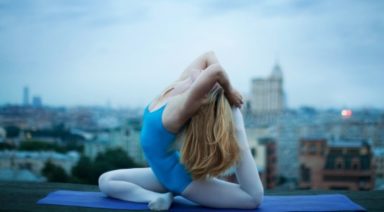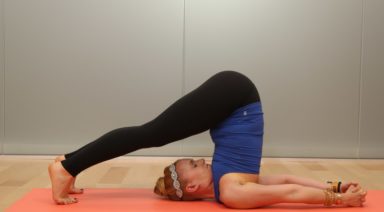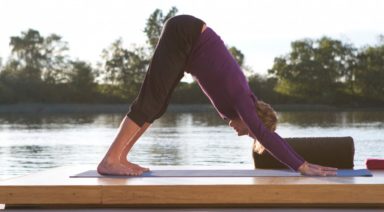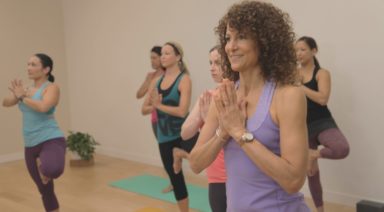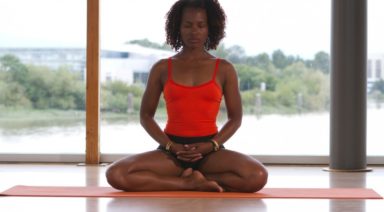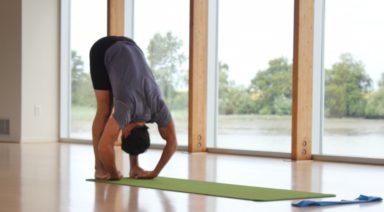Have Niche Yoga Styles Taken It Too Far?

What does yoga look like when no one is looking?
The answer to the question depends on who we are watching. What yoga looks like can vary widely, especially because there are 4 main kinds of yoga: The yoga of intelligence (jnana), the yoga of devotion (bhakti), the yoga of service (karma), and hatha yoga which is the one we think of when we see people doing downward dog. Yoga for one person may look like studying scripture and attending dharma talks. While for someone else, it’s doing service to their community without expectation of getting anything in return.
For another individual, yoga is chanting and repeating the same kriya for an hour every single day. Someone doing an hour-long physical yoga class, breathing, resting at the end, and saying “OM” might be more of what we’ve come to recognize yoga as today. So whether sitting silently on a cushion for hours or doing plank while drinking a microbrew, we can technically call it yoga.
If you ask someone in the East, someone in the West, someone today, and someone from the past, their answers can vary as widely as the styles of yoga offered. So is any of the yoga we see taking it too far?
Is ‘fun and done’ yoga still yoga?
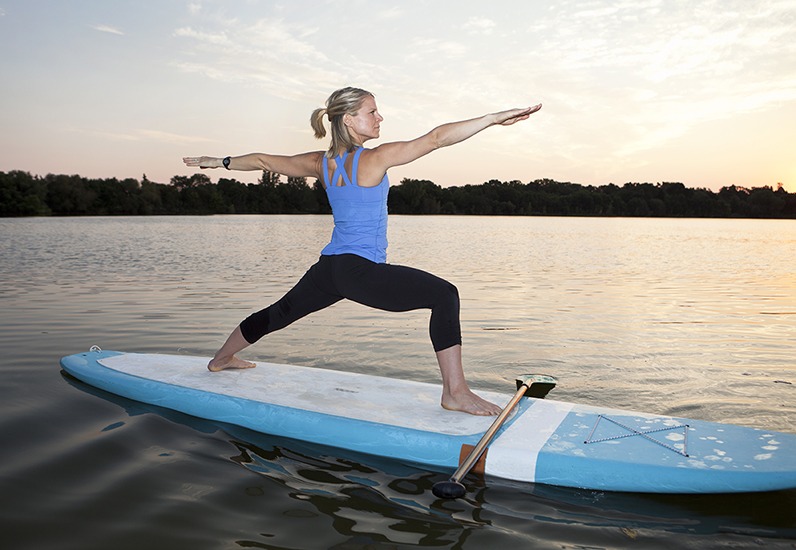
People have short attention spans. Multi-tasking is the norm. We are accustomed to 15-second commercials, next day delivery, 18-minute educational Ted Talks, and seven-minute workouts. We want things quickly and we want results now. Oh, dopamine! We want to click on one tab to bring us to another and then we get lost down a rabbit hole on the internet, rather than complete one task, we get lost in the shuffle. This spastic and brain-draining way of using our attention lacks depth, true focus, and the willingness to delay gratification. Delaying gratification comes with a number of benefits. That is why a lifelong practice of yoga can be ultimately gratifying with dedication over a lifespan. So is there value in the ‘fun and done’ niche yoga world?
The short attention span culture we live in craves a constant stream of entertainment and novelty. We want things catered to our exact interests and we want it now. More than 36 million Americans are practicing yoga (source: Harvard Health Publishing). Because we are used to being consumers in this strange new world, we can expect there to be yoga to meet our exact demands. Therefore, it makes sense that we provide many kinds of yoga that feel fun, trendy, and Insta-worthy. But if we cannot take these experiences for fun and then integrate them into a regular yoga practice, then perhaps we are taking it too far. On the other hand, if we can draw new people into yoga, bring joy and provide much needed in-person socialization, culture, and entertainment, we are providing a tremendous value that people are willing to show up for it.
I have to admit I have scoffed at goat yoga and rolled my eyes at beer yoga. These new trends in yoga popped up after others that have been around and once seemed unconventional.
SUP yoga is yoga on paddleboards, yoga-pilates fusion combines two forms of exercise and is less meditative and more exercise-focused, and chair yoga allows people to do poses while supported by chairs. These different offerings became the norm to give athletes, the elderly, and everyone in between an entry point into yoga. They have become fixtures in our modern yoga world. And now, niche classes such as yoga at art museums and breweries get people’s attention and match their interests. These special event yoga classes are the SUP and vinyasa yoga of today, drawing huge crowds, big money, and hopefully helping people.
Individuals that may otherwise skip yoga are drawn to these classes. Some of the attendees may be newcomers to yoga. These trending classes may also attract regular yogis that typically go to the same classes with the same instructors, reinvigorating their enthusiasm for yoga and connecting them to others. Perhaps the novelty keeps it feeling fresh and new while giving practitioners a way to socialize face-to-face.
The end result of all these offerings is people experiencing yoga. And if it brings them into themselves, facilitating a march down a healing path, even if it isn’t traditional, then there is a benefit. The caveat being that the new yogi also goes beyond the fun to truly experience yoga as it is designed. If people are only coming to yoga for the fun, then it is being stripped down to an unrecognizable form. After all, the poses being taught at these events are only one of 8 limbs of the yoga path, and hatha yoga is only one of the 4 pillars of yoga. There is more to experience and more to study.
How to Stay True to Yoga at a Specialty Class:
-
Connect to your needs and meet them on the mat.
-
Remember to breathe.
-
Pause to experience gratitude.
-
Feel your body.
-
Notice your surroundings.
-
Relish in a quiet moment of prayerful meditation.
-
Thank your teacher.
Everyone Has a Specialty
As more and more people become certified to teach yoga, the business model of teaching studio classes can not pay the bills for everyone. For economic reasons newcomers and veterans teachers alike have been forced to think outside the box. They want to cater to people’s lifestyles and interests. Therefore yoga at museums, on hotel poolsides, and on surfboards makes financial sense.
There is a desire to tailor yoga to instructor expertise. As a result of more people attending yoga trainings, different specialities are popping up based on the professional and academic backgrounds of graduates that seem to create something entirely new. Therefore, with a combination of a wide variety of practitioner interest and ability, an economic need for novel class offerings, and the diverse expertise of instructors, we can continue to expect new yoga fusion cocktails to be mixed up. And should we drink them up?
It is a personal decision for each yogi to make regarding the style, frequency, and commitment we make to yoga. Power to the people that enjoy teaching or attending large public classes on a farm or in a microbrewery. Still, the shift we seek from yoga will only happen from regular, dedicated practice of integrity. Yoga can look like a lot of things. We can choose from such a wide variety of yoga. So then the question must shift from, ‘has yoga gone too far? to ‘how do we want to feel as a result of our practice?’It is then we can make an informed decision. It is then we can be empowered by choice.
What is Hatha Yoga?

If you’ve been practicing yoga for any length of time, you’ve probably heard of Patanjali’s Yoga Sutras. The text, which was written around the second century CE, consists of a compilation of yoga practices derived from older Hindu and Buddhist yogic traditions. Consisting of four chapters of 196 aphorisms, the text enumerates the eight-limbed ashtanga approach to yoga.
Patanjali’s ashtanga yoga system, (not to be confused with the contemporary ashtanga system of Pattabhi Jois) details a full overview of yogic practices. It includes social and ethical precepts, (yama and niyama) guidelines for physical practices, (asana and pranayama) and a full overview of mental states that arise during meditative concentration (pratyahara, dharana, dhyana and Samadhi).
Yoga as a Cohesive System
The Yoga Sutras are important because it was the first time that the central elements of Yogic theory and practice had been collected and documented in one place. Before Patanjali, most textual mentions of yoga were scattered among a large number of manuscripts from different traditions. During that time, anyone wishing to engage in a full comprehensive overview of yogic practices would be required to learn a number of different languages in order to study a diverse number of traditional texts drawn from Hindu, Buddhist and Jain sources.
Once Patanjali had codified this systematic approach to yoga practices, the practice itself became more accessible. As a result yoga continued to mature as a discipline over the coming centuries. With time, other full-fledged yogic systems came into being as well. One of the most well-known systems – Hatha Yoga (the forceful yoga) began to develop sometime between the 9th and 12th century CE.
The Godfather of Hatha Yoga: Gorakshanath
Hindu traditions accredit the creation of Hatha Yoga to Gorakshanath and his teacher Matsyendranath. Both of these men were Bengali in origin. Goraksha Nath in particular was recognized as a highly accomplished practitioner, and was considered by many to be a miracle worker, saint, and revered teacher during his time. During his time, he founded the Nath movement in Northern India.
Known to have drawn inspiration from both Buddhist and Hindu sources, Gorakshanath is accredited with the creation of a number of important oral teachings and Sanskrit texts. These texts include The Siddha Siddhanta Paddhati, and a separate important treaty on Hatha Yoga, titled the Goraksa Sataka.
With time, other well-known Hatha Yoga practitioners continued to contribute to the Hatha Yoga canon and additional texts were written to support the practice as well. The Hatha Yoga Pradipika (15th century) and Gheranda Samhita (17th century) – both anthologies of various texts – are important treatises on the practice of Hatha Yoga.
Divine Purification through Physical Means
Though many of the tenants and practices of Hatha Yoga parallel the eight limbed system found in the Yoga Sutras of Patanjali, there are substantial differences as well. The Hatha yoga of Goraksha Nath established a close connection between Indian medicine, and the principles of yoga and alchemy. As such, traditional Hatha Yoga teachings tended to emphasize physical practices more extensively than did the Yoga Sutras.
Like the Yoga Sutras, the ultimate aim of the Hatha Yogi was enlightenment. However, the practices differed substantially in their respective methodologies. Followers of the Yoga Sutras believed that the restraint of consciousness was the way to achieve liberation. In contrast, Hatha Yogis believed that liberation could be more quickly achieved through a sophisticated set of transformational practices designed to purify the physical body and mind through energy practices.
To begin these practices, Hatha Yogis were required to perform extensive purification rituals before beginning asana and pranayama practices under the careful guidance of a guru.
As part of their training, students of Hatha Yoga were also required to learn a comprehensive energy map of the body. This map contained among other things an overview of channels (nadis), chakras (energy wheels), winds (vayus) and “drops” (bindu) consisting of male (lunar) and female (solar) energies.
Once the Hatha Yogi had completed this preliminary work, they engaged in a persistent, daily effort to force the body’s energy winds (vayus) to enter the central energy channel (Susumna). The energy from these winds was then used to unite contrasting polarities of masculine and feminine energy.
The term Hatha makes reference to this practice and is often explained as the conjunction of the feminine solar force – represented by the syllable HA – and the masculine lunar force symbolized by the syllable THA.
Typically, this process of conjoining energies was accomplished through a combination of physical asanas, breathing exercises and meditative contemplations based on deities.
The overall aim of this practice of conjoining energies was to activate the vital life force (Kundulini) that is said to lie dormant in the central channel. In the Buddhist tradition of Hatha Yoga (Naljor), practitioners activate a great heat at the navel chakra. This heat was then used to induce four states of bliss that could provide deeper insights into the ultimate nature of reality.
Through this process the Hatha Yoga gradually strove to transform the physical body into a subtle, divine body. This body, (sometimes referred to as the adamantine body or vajra body) was said to be purer than the sky impervious to disease, void of any defects, eternally youthful, and the bearer of paranormal, magical powers.
Techniques and Benefits of Hatha Yoga
While asana and pranayama played an important role in Hatha Yoga practices, other disciplines were used for physical purification as well. The Gheranda Samhita, a seventeenth century manual of Hatha Yoga, lists six separate purification practices that were used to achieve the adamantine body by tempering the physical body through the fire of yoga.”
These practices include:
Neti
Neti practices primarily consist of nasal cleansing exercises with oil, water or a thin string. Benefits of this practice include lubrication of the mucous membrane, less susceptibility to colds, an improvement in allergy related symptoms and a clearing of the nasal passages.
Dhauti
These cleansing techniques include a diverse set of practices to cleanse the stomach with a combination of saline solutions, air, or a long swath of cotton cloth. Benefits of these practices are said to include an alleviation of constipation, indigestion, hypo and hyper acidity.
Nauli
This forceful exercise consists of a strong rotation of the abdominal muscles and is said to stimulate digestion, tone the abdominal organs and massage the internal organs.
Vasti
Vasti practices utilize various types of enema to encourage the expulsion of accumulated toxins in the colon. Benefits of this Hatha Yoga practice can include regular bowel movements and increased digestive health.
Kapalabhati
Also called the skull shining breath, Kapalabhati is an active breathing practice that can be used to purify energy channels, calm the mind and tone the abdominal muscles.
Trataka
In Hatha Yoga, trataka exercises are used to purify the eyes. To do this exercise, the practitioner fixes his or her eyes on a single point for extended periods of time. Regular practice of trataka can improve the ability to concentrate and deepen meditative practices.
Adaptation to the Modern World
Traditional Hindu and Buddhist Hatha Yoga is still practiced to this day in unaltered form in Tibetan Buddhist monasteries and Hindu ashrams around the world. However, Hatha Yoga as a whole has continued to evolve and adapt to fit the needs of the modern world.
Since the turn of the 20th century, the Hatha Yoga postural corpus has continued to grow. During the Hatha Yoga Renaissance, there were less than 100 recognized yoga postures. Today, this number has grown to thousands of potential variations which are regularly practiced in yoga studios throughout the world.
Three Indian teachers in the early part of the twentieth century contributed to the ever-changing landscape of Hatha Yoga practice through independent study and practice.
By expanding the Hatha Yoga repertoire and presenting it not only to the uninitiated layman, but to women as well, these teachers popularized the practice and made it available to millions around the world.
Swami Kuvalayananda focused primarily on the health benefits of practicing yoga; Swami Sivananda in Rishikesh fused together three different types of practice (Karma, Jnana and Bhakti) to create a modern approach to yoga, and T. Krishnamacharya (the teacher of B.K.S. Iyengar and Pattabhi Jois) of Mysore concentrated on developing a larger and more varied postural repository by integrating an eclectic array of exercises from other movement disciplines into the practice.




